Porosity of Geopolymers Using Complementary Techniques of Image Analysis and Physical Adsorption of Gases
Abstract
1. Introduction
2. Materials and Methods
2.1. Materials
2.2. Geopolymer Mortars
2.3. SEM Analysis
Determination of the Paste-Aggregate Mask
2.4. Physical Adsorption of Gases
3. Results and Discussion
3.1. Image Analysis
3.2. Physical Adsorption of Gases Analysis and Compressive Strength
4. Conclusions
Author Contributions
Funding
Data Availability Statement
Acknowledgments
Conflicts of Interest
References
- Ige, O.E.; Von Kallon, D.V.; Desai, D. Carbon Emissions Mitigation Methods for Cement Industry Using a Systems Dynamics Model. Clean Technol. Environ. Policy 2024, 26, 579–597. [Google Scholar]
- Nilimaa, J. Smart Materials and Technologies for Sustainable Concrete Construction. Dev. Built Environ. 2023, 15, 100177. [Google Scholar] [CrossRef]
- Lehne, J.; Preston, F. Making Concrete Change. Innovation in Low-Carbon Cement and Concrete; Chatham House: London, UK, 2018; Volume 13. [Google Scholar]
- Mohamad, N.; Muthusamy, K.; Embong, R.; Kusbiantoro, A.; Hashim, M.H. Environmental Impact of Cement Production and Solutions: A Review. Mater. Today Proc. 2022, 48, 741–746. [Google Scholar] [CrossRef]
- Ige, O.E.; Olanrewaju, O.A.; Duffy, K.J.; Obiora, C. A Review of the Effectiveness of Life Cycle Assessment for Gauging Environmental Impacts from Cement Production. J. Clean. Prod. 2021, 324, 129213. [Google Scholar] [CrossRef]
- Onyenokporo, N.C. Supplementary Cementitious Materials as Sustainable Partial Replacement for Cement in the Building Industry. Int. J. Archit. Environ. Eng. 2022, 16, 74–84. [Google Scholar]
- Fantilli, A.P.; Jóźwiak-Niedźwiedzka, D. Supplementary Cementitious Materials in Concrete, Part I. Materials 2021, 14, 2291. [Google Scholar] [CrossRef]
- Assumptor, O.M.; Masika, E.; Thiong’o, K. Probing Optimal Blends of Pozzolans to Develop Supplementary Cementing Material Within Busia County, Kenya. J. Appl. Phys. 2020, 12, 59–69. [Google Scholar]
- Zhang, C.S.; Gu, X.S.; Gao, J.; Yang, Y.; Zhu, B.G. Preparation and Mechanical Performance of Supplementary Cementing Materials Cementitious by Electroplating Sludge. In Proceedings of the Key Engineering Materials; Trans Tech Publications: Bäch, Switzerland, 2020; Volume 837, pp. 133–138. [Google Scholar]
- Panesar, D.K.; Zhang, R. Performance Comparison of Cement Replacing Materials in Concrete: Limestone Fillers and Supplementary Cementing Materials–A Review. Constr. Build. Mater. 2020, 251, 118866. [Google Scholar] [CrossRef]
- Giergiczny, Z. Fly Ash and Slag. Cem. Concr. Res. 2019, 124, 105826. [Google Scholar] [CrossRef]
- Klima, K.M.; Schollbach, K.; Brouwers, H.J.H.; Yu, Q. Thermal and Fire Resistance of Class F Fly Ash Based Geopolymers—A Review. Constr. Build. Mater. 2022, 323, 126529. [Google Scholar] [CrossRef]
- Abdulrahman, H.; Muhamad, R.; Visintin, P.; Azim Shukri, A. Mechanical Properties and Bond Stress-Slip Behaviour of Fly Ash Geopolymer Concrete. Constr. Build. Mater. 2022, 327, 126909. [Google Scholar] [CrossRef]
- Xu, X.; Bao, S.; Guo, Z.; Tian, X. A Clean Approach to High-Strength Fly Ash-Based Geopolymers: Multi-Granular Screening with NaAlO2 Enhancement. J. Clean. Prod. 2024, 464, 142733. [Google Scholar] [CrossRef]
- John, S.K.; Nadir, Y.; Girija, K. Effect of Source Materials, Additives on the Mechanical Properties and Durability of Fly Ash and Fly Ash-Slag Geopolymer Mortar: A Review. Constr. Build. Mater. 2021, 280, 122443. [Google Scholar] [CrossRef]
- Li, X.; Bai, C.; Qiao, Y.; Wang, X.; Yang, K.; Colombo, P. Preparation, Properties and Applications of Fly Ash-Based Porous Geopolymers: A Review. J. Clean. Prod. 2022, 359, 132043. [Google Scholar] [CrossRef]
- Zhuang, X.Y.; Chen, L.; Komarneni, S.; Zhou, C.H.; Tong, D.S.; Yang, H.M.; Yu, W.H.; Wang, H. Fly Ash-Based Geopolymer: Clean Production, Properties and Applications. J. Clean. Prod. 2016, 125, 253–267. [Google Scholar] [CrossRef]
- Wattimena, O.K.; Antoni, A.; Hardjito, D. A Review on the Effect of Fly Ash Characteristics and Their Variations on the Synthesis of Fly Ash Based Geopolymer. AIP Conf. Proc. 2017, 1887, 020041. [Google Scholar]
- Komljenović, M.; Baščarević, Z.; Bradić, V. Mechanical and Microstructural Properties of Alkali-Activated Fly Ash Geopolymers. J. Hazard. Mater. 2010, 181, 35–42. [Google Scholar] [CrossRef]
- Ge, X.; Liu, Y.; Mao, Y.; Hu, X.; Shi, C. Characteristics of Fly Ash-Based Geopolymer Concrete in the Field for 4 Years. Constr. Build. Mater. 2023, 382, 131222. [Google Scholar] [CrossRef]
- Soutsos, M.; Boyle, A.P.; Vinai, R.; Hadjierakleous, A.; Barnett, S.J. Factors Influencing the Compressive Strength of Fly Ash Based Geopolymers. Constr. Build. Mater. 2016, 110, 355–368. [Google Scholar] [CrossRef]
- Mohammed, A.A.; Ahmed, H.U.; Mosavi, A. Survey of Mechanical Properties of Geopolymer Concrete: A Comprehensive Review and Data Analysis. Materials 2021, 14, 4690. [Google Scholar] [CrossRef]
- Nikoloutsopoulos, N.; Sotiropoulou, A.; Kakali, G.; Tsivilis, S. Physical and Mechanical Properties of Fly Ash Based Geopolymer Concrete Compared to Conventional Concrete. Buildings 2021, 11, 178. [Google Scholar] [CrossRef]
- Yu, G.; Jia, Y. Microstructure and Mechanical Properties of Fly Ash-Based Geopolymer Cementitious Composites. Minerals 2022, 12, 853. [Google Scholar] [CrossRef]
- Payakaniti, P.; Chuewangkam, N.; Yensano, R.; Pinitsoontorn, S.; Chindaprasirt, P. Changes in Compressive Strength, Microstructure and Magnetic Properties of a High-Calcium Fly Ash Geopolymer Subjected to High Temperatures. Constr. Build. Mater. 2020, 265, 120650. [Google Scholar] [CrossRef]
- Mortar, N.A.M.; Kamarudin, H.; Rafiza, R.A.; Meor, T.A.F.; Rosnita, M. Compressive Strength of Fly Ash Geopolymer Concrete by Varying Sodium Hydroxide Molarity and Aggregate to Binder Ratio. IOP Conf. Ser. Mater. Sci. Eng. 2020, 864, 012037. [Google Scholar] [CrossRef]
- Zeyad, A.M.; Johari, M.A.M.; Abutaleb, A.; Tayeh, B.A. The Effect of Steam Curing Regimes on the Chloride Resistance and Pore Size of High–Strength Green Concrete. Constr. Build. Mater. 2021, 280, 122409. [Google Scholar] [CrossRef]
- Luhar, I.; Luhar, S. A Comprehensive Review on Fly Ash-Based Geopolymer. J. Compos. Sci. 2022, 6, 219. [Google Scholar] [CrossRef]
- Aghajanian Sabbagh, A.; Cimentada Hernández, A.I.; Fayyaz, M.; Brand, A.S. Thomas García Emerging Material for Sustainable Construction. Constr. Build. Mater. 2014, 56, 113–127. [Google Scholar]
- Ziejewska, C.; Grela, A.; Hebda, M. Influence of Waste Glass Particle Size on the Physico-Mechanical Properties and Porosity of Foamed Geopolymer Composites Based on Coal Fly Ash. Materials 2023, 16, 2044. [Google Scholar] [CrossRef]
- Liu, R.; Chi, Y.; Chen, S.; Jiang, Q.; Meng, X.; Wu, K.; Li, S. Influence of Pore Structure Characteristics on the Mechanical and Durability Behavior of Pervious Concrete Material Based on Image Analysis. Int. J. Concr. Struct. Mater. 2020, 14, 29. [Google Scholar] [CrossRef]
- Chinchillas-Chinchillas, M.J.; Rosas-Casarez, C.A.; Arredondo-Rea, S.P.; Gómez-Soberón, J.M.; Corral-Higuera, R. SEM Image Analysis in Permeable Recycled Concretes with Silica Fume. A Quantitative Comparison of Porosity and the ITZ. Materials 2019, 12, 2201. [Google Scholar] [CrossRef]
- Zarębska, K.; Szczurowski, J.; Gazda-Grzywacz, M.; Wróbel, W.; Bator, J.; Baran, P. Geopolymer Building Materials Based on Fly Ash in Terms of Removing SO2, CO2, and Water Vapor. Energies 2023, 16, 5188. [Google Scholar] [CrossRef]
- Gunasekara, C.; Law, D.W.; Setunge, S. Long Term Permeation Properties of Different Fly Ash Geopolymer Concretes. Constr. Build. Mater. 2016, 124, 352–362. [Google Scholar] [CrossRef]
- Zhang, P.; Han, X.; Guo, J.; Zhang, H. Fractal Characteristics of Geopolymer Mortar Containing Municipal Solid Waste Incineration Fly Ash and Its Correlations to Pore Structure and Strength. Fractal Fract. 2022, 6, 676. [Google Scholar] [CrossRef]
- Benavente, D.; Such-Basañez, I.; Fernandez-Cortes, A.; Pla, C.; Cazorla-Amoros, D.; Cañaveras, J.C.; Sanchez-Moral, S. Comparative Analysis of Water Condensate Porosity Using Mercury Intrusion Porosimetry and Nitrogen and Water Adsorption Techniques in Porous Building Stones. Constr. Build. Mater. 2021, 288, 123131. [Google Scholar] [CrossRef]
- Rosas-Casarez, C.A.; Arredondo-Rea, S.P.; Cruz-Enríquez, A.; Corral-Higuera, R.; Pellegrini-Cervantes, M.d.J.; Gómez-Soberón, J.M.; Medina-Serna, T.d.J. Influence of Size Reduction of Fly Ash Particles by Grinding on the Chemical Properties of Geopolymers. Appl. Sci. 2018, 8, 365. [Google Scholar] [CrossRef]
- ASTM C33; ASTM C33 Standard Specifications for Concrete Aggregates. ASTM: West Conshohocken, PA, USA, 2003.
- Aghajanian Sabbagh, A.; Cimentada Hernández, A.I.; Fayyaz, M.; Brand, A.S.; Thomas García, C. ITZ Microanalysis of Cement-Based Building Materials with Incorporation of Siderurgical Aggregates. J. Build. Eng. 2023, 67, 106008. [Google Scholar] [CrossRef]
- Waris, M.I.; Plevris, V.; Mir, J.; Chairman, N.; Ahmad, A. An Alternative Approach for Measuring the Mechanical Properties of Hybrid Concrete through Image Processing and Machine Learning. Constr. Build. Mater. 2022, 328, 126899. [Google Scholar] [CrossRef]
- Lloyd, R.R.; Provis, J.L.; Van Deventer, J.S.J. Microscopy and Microanalysis of Inorganic Polymer Cements. 1: Remnant Fly Ash Particles. J. Mater. Sci. 2009, 44, 608–619. [Google Scholar] [CrossRef]
- Zailani, W.W.A.; Abdullah, M.M.A.; Arshad, M.F.; Burduhos-Nergis, D.D.; Tahir, M.F.M. Effect of Iron Oxide (Fe2O3) on the Properties of Fly Ash Based Geopolymer. IOP Conf. Ser. Mater. Sci. Eng. 2020, 877, 012017. [Google Scholar] [CrossRef]
- Lyu, K.; She, W.; Chang, H.; Gu, Y. Effect of Fine Aggregate Size on the Overlapping of Interfacial Transition Zone (ITZ) in Mortars. Constr. Build. Mater. 2020, 248, 118559. [Google Scholar] [CrossRef]
- Gualtieri, M.L.; Cavallini, A.; Romagnoli, M. Interactive Powder Mixture Concept for the Preparation of Geopolymers with Fine Porosity. J. Eur. Ceram. Soc. 2016, 36, 2641–2646. [Google Scholar] [CrossRef]
- Masi, G.; Rickard, W.D.A.; Vickers, L.; Bignozzi, M.C.; Van Riessen, A. A Comparison between Different Foaming Methods for the Synthesis of Light Weight Geopolymers. Ceram. Int. 2014, 40, 13891–13902. [Google Scholar] [CrossRef]
- Diamond, S. Considerations in Image Analysis as Applied to Investigations of the ITZ in Concrete. Cem. Concr. Compos. 2001, 23, 171–178. [Google Scholar] [CrossRef]
- Head, M.K.; Buenfeld, N.R. Measurement of Aggregate Interfacial Porosity in Complex, Multi-Phase Aggregate Concrete: Binary Mask Production Using Backscattered Electron, and Energy Dispersive X-Ray Images. Cem. Concr. Res. 2006, 36, 337–345. [Google Scholar] [CrossRef]
- Kapadia, H.; Soneji, N.; Rotti, A.; Patel, P.V.; Patel, J.B. Monitoring and Analysis of Surface Cracks in Concrete Using Convolutional Neural Network. In Proceedings of the International Conference on Structural Engineering and Construction Management; Springer: Berlin/Heidelberg, Germany, 2022; pp. 1215–1228. [Google Scholar]
- Yang, S.; Braham, A. R-Curves Characterisation Analysis for Asphalt Concrete. Int. J. Pavement Eng. 2018, 19, 99–108. [Google Scholar] [CrossRef]
- Diamond, S.; Huang, J. The ITZ in Concrete–a Different View Based on Image Analysis and SEM Observations. Cem. Concr. Compos. 2001, 23, 179–188. [Google Scholar] [CrossRef]
- Alanazi, H. Study of the Interfacial Transition Zone Characteristics of Geopolymer and Conventional Concretes. Gels 2022, 8, 105. [Google Scholar] [CrossRef]
- Golewski, G.L. Evaluation of Morphology and Size of Cracks of the Interfacial Transition Zone (ITZ) in Concrete Containing Fly Ash (FA). J. Hazard. Mater. 2018, 357, 298–304. [Google Scholar] [CrossRef]
- Ren, X.; Zhang, L. Experimental Study of Interfacial Transition Zones between Geopolymer Binder and Recycled Aggregate. Constr. Build. Mater. 2018, 167, 749–756. [Google Scholar] [CrossRef]
- Singh, B.; Rahman, M.R.; Paswan, R.; Bhattacharyya, S.K. Effect of Activator Concentration on the Strength, ITZ and Drying Shrinkage of Fly Ash/Slag Geopolymer Concrete. Constr. Build. Mater. 2016, 118, 171–179. [Google Scholar] [CrossRef]
- Aughenbaugh, K.L.; Stutzman, P.; Juenger, M.C.G. Assessment of the Glassy Phase Reactivity in Fly Ashes Used for Geopolymer Cements. Geopolym. Bind. Syst. 2013, 1566, 11–20. [Google Scholar]
- Sun, Q.; Zhao, S.; Zhao, X.; Song, Y.; Ban, X.; Zhang, N. Influence of Different Grinding Degrees of Fly Ash on Properties and Reaction Degrees of Geopolymers. PLoS ONE 2023, 18, e0282927. [Google Scholar] [CrossRef] [PubMed]
- Debnath, K.; Das, D.; Rout, P.K. Effect of Mechanical Milling of Fly Ash Powder on Compressive Strength of Geopolymer. Mater. Today Proc. 2022, 68, 242–249. [Google Scholar] [CrossRef]
- Peng, H.; Cui, C.; Cai, C.S.; Liu, Y.; Liu, Z. Microstructure and Microhardness Property of the Interface between a Metakaolin/GGBFS-Based Geopolymer Paste and Granite Aggregate. Constr. Build. Mater. 2019, 221, 263–273. [Google Scholar] [CrossRef]
- Rangaraju, P.R.; Olek, J.; Diamond, S. An Investigation into the Influence of Inter-Aggregate Spacing and the Extent of the ITZ on Properties of Portland Cement Concretes. Cem. Concr. Res. 2010, 40, 1601–1608. [Google Scholar] [CrossRef]
- Luo, Z.; Li, W.; Wang, K.; Castel, A.; Shah, S.P. Comparison on the Properties of ITZs in Fly Ash-Based Geopolymer and Portland Cement Concretes with Equivalent Flowability. Cem. Concr. Res. 2021, 143, 106392. [Google Scholar] [CrossRef]
- Sing, K.S.W. Reporting Physisorption Data for Gas/Solid Systems with Special Reference to the Determination of Surface Area and Porosity (Recommendations 1984). Pure Appl. Chem. 1985, 57, 603–619. [Google Scholar] [CrossRef]
- Xiong, L.; Wan, Z.; Zhang, Y.; Wang, F.; Wang, J.; Kang, Y. Fly Ash Particle Size Effect on Pore Structure and Strength of Fly Ash Foamed Geopolymer. Adv. Polym. Technol. 2019, 2019, 1098027. [Google Scholar] [CrossRef]
- Li, Y.; Dong, Y.; El-Naggar, M.R.; Wang, F.; Zhao, Y. The Influence of Particle Size and Calcium Content on Performance Characteristics of Metakaolin-and Fly-Ash-Based Geopolymer Gels. Gels 2024, 10, 639. [Google Scholar] [CrossRef]
- Su, L.; Fu, G.; Liang, B.; Sun, Q.; Zhang, X. Mechanical Properties and Microstructure Evaluation of Fly Ash-Slag Geopolymer Foaming Materials. Ceram. Int. 2022, 48, 18224–18237. [Google Scholar] [CrossRef]
- Chen, K.; Lin, W.-T.; Liu, W. Effect of NaOH Concentration on Properties and Microstructure of a Novel Reactive Ultra-Fine Fly Ash Geopolymer. Adv. Powder Technol. 2021, 32, 2929–2939. [Google Scholar] [CrossRef]
- De Boer, J.H. The Structure and Properties of Porous Materials; Butterworths: London, UK, 1958. [Google Scholar]
- Keluo, C.; Zhang, T.; Xiaohui, C.; Yingjie, H.E.; Liang, X. Model Construction of Micro-Pores in Shale: A Case Study of Silurian Longmaxi Formation Shale in Dianqianbei Area, SW China. Pet. Explor. Dev. 2018, 45, 412–421. [Google Scholar]
- Martín Martínez, J.M. Generalidades Sobre Adsorción Física de Gases y Vapores En Carbones. In Adsorción Física de Gases y Vapores por Carbones; Universidad de Alicante: Alicante, Spain, 1990; p. 42. [Google Scholar]
- Seifi, S.; Levacher, D.; Razakamanantsoa, A.; Sebaibi, N. Microstructure of Dry Mortars without Cement: Specific Surface Area, Pore Size and Volume Distribution Analysis. Appl. Sci. 2023, 13, 5616. [Google Scholar] [CrossRef]
- Zhang, S.; Tang, S.; Tang, D.; Huang, W.; Pan, Z. Determining Fractal Dimensions of Coal Pores by FHH Model: Problems and Effects. J. Nat. Gas Sci. Eng. 2014, 21, 929–939. [Google Scholar] [CrossRef]
- Xu, L.; Zhang, J.; Ding, J.; Liu, T.; Shi, G.; Li, X.; Dang, W.; Cheng, Y.; Guo, R. Pore Structure and Fractal Characteristics of Different Shale Lithofacies in the Dalong Formation in the Western Area of the Lower Yangtze Platform. Minerals 2020, 10, 72. [Google Scholar] [CrossRef]
- Friesen, W.I.; Mikula, R.J. Fractal Dimensions of Coal Particles. J. Colloid Interface Sci. 1987, 120, 263–271. [Google Scholar] [CrossRef]
- Zhang, L.; Lu, S.; Xiao, D.; Gu, M. Characterization of Full Pore Size Distribution and Its Significance to Macroscopic Physical Parameters in Tight Glutenites. J. Nat. Gas Sci. Eng. 2017, 38, 434–449. [Google Scholar] [CrossRef]
- Gaurav, G.; Kandpal, S.C.; Mishra, D.; Kotoky, N. A Comprehensive Review on Fly Ash-Based Geopolymer: A Pathway for Sustainable Future. J. Sustain. Cem. Mater. 2024, 13, 100–144. [Google Scholar] [CrossRef]
- Pradhan, P.; Dwibedy, S.; Pradhan, M.; Panda, S.; Panigrahi, S.K. Durability Characteristics of Geopolymer Concrete-Progress and Perspectives. J. Build. Eng. 2022, 59, 105100. [Google Scholar] [CrossRef]
- Aziz, I.H.A.; Abdullah, M.M.A.B.; Razak, R.A.; Yahya, Z.; Salleh, M.A.A.M.; Chaiprapa, J.; Rojviriya, C.; Vizureanu, P.; Sandu, A.V.; Tahir, M.F. Mechanical Performance, Microstructure, and Porosity Evolution of Fly Ash Geopolymer after Ten Years of Curing Age. Materials 2023, 16, 1096. [Google Scholar] [CrossRef]
- Sharma, P.K.; Singh, J.P.; Kumar, A. Effect of Particle Size on Physical and Mechanical Properties of Fly Ash Based Geopolymers. Trans. Indian Inst. Met. 2019, 72, 1323–1337. [Google Scholar] [CrossRef]
- Jaya, N.A.; Yun-Ming, L.; Cheng-Yong, H.; Abdullah, M.M.A.B.; Hussin, K. Correlation between Pore Structure, Compressive Strength and Thermal Conductivity of Porous Metakaolin Geopolymer. Constr. Build. Mater. 2020, 247, 118641. [Google Scholar] [CrossRef]


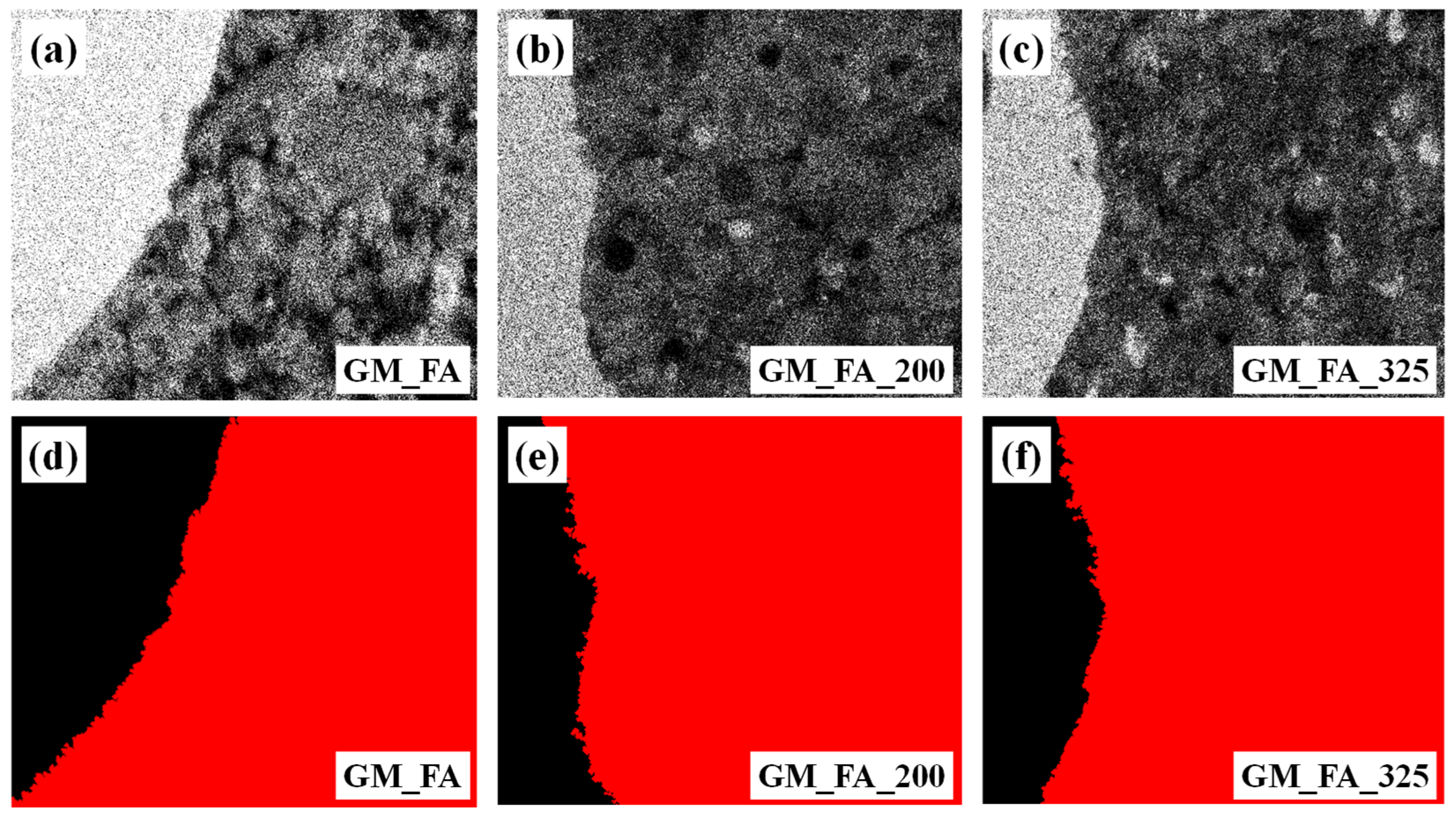
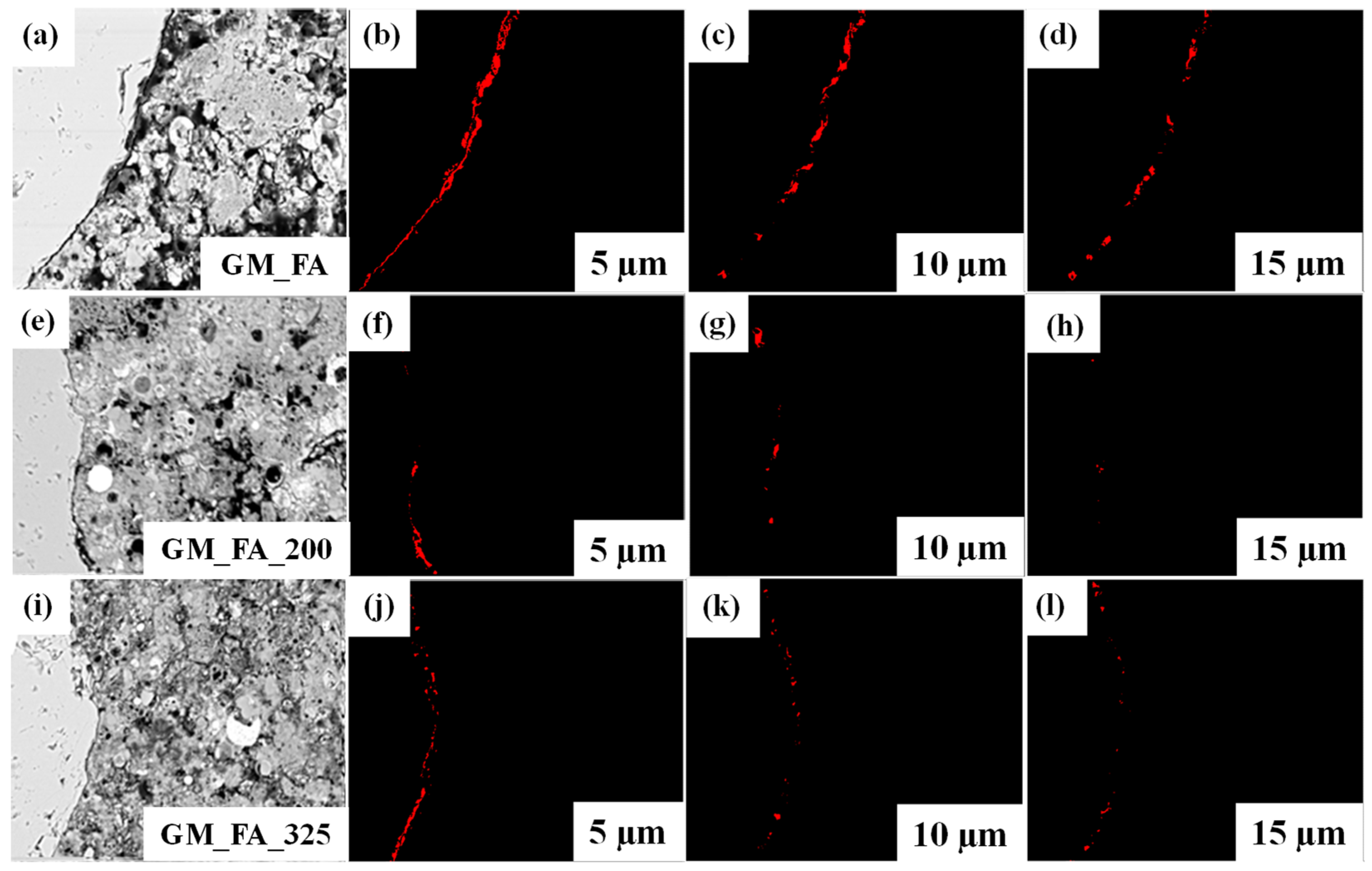


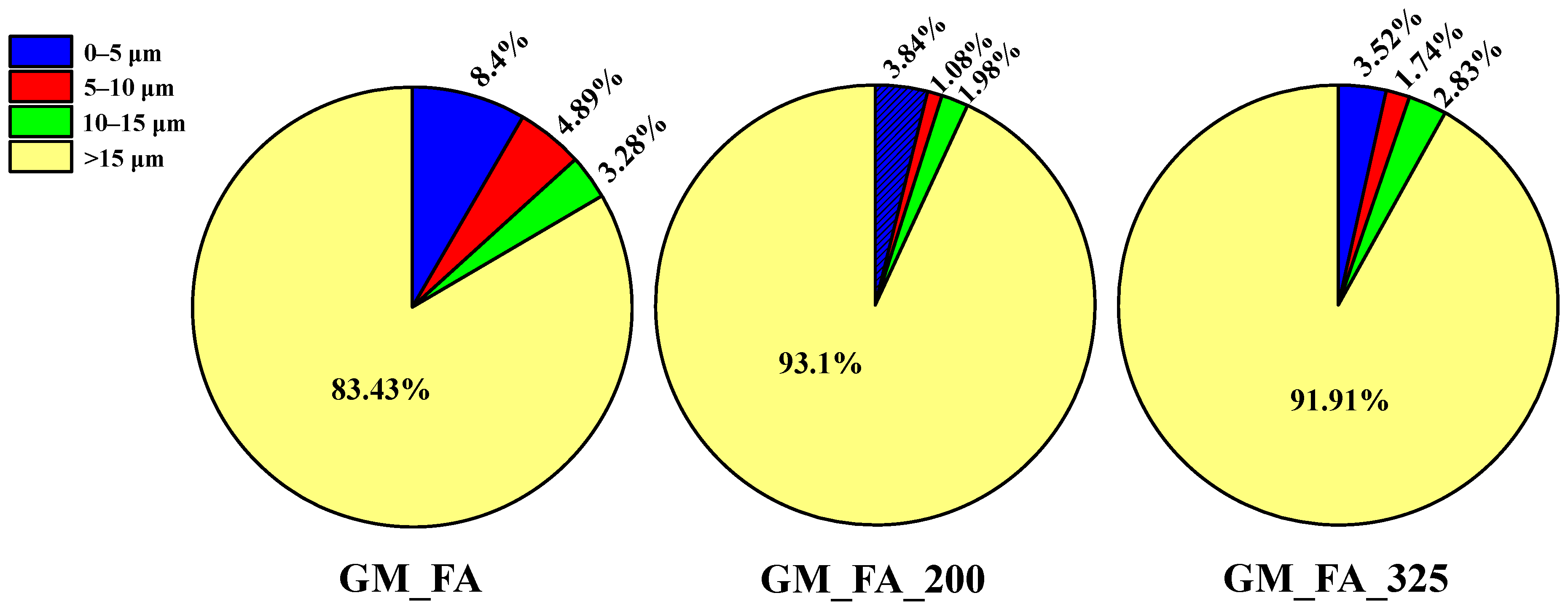
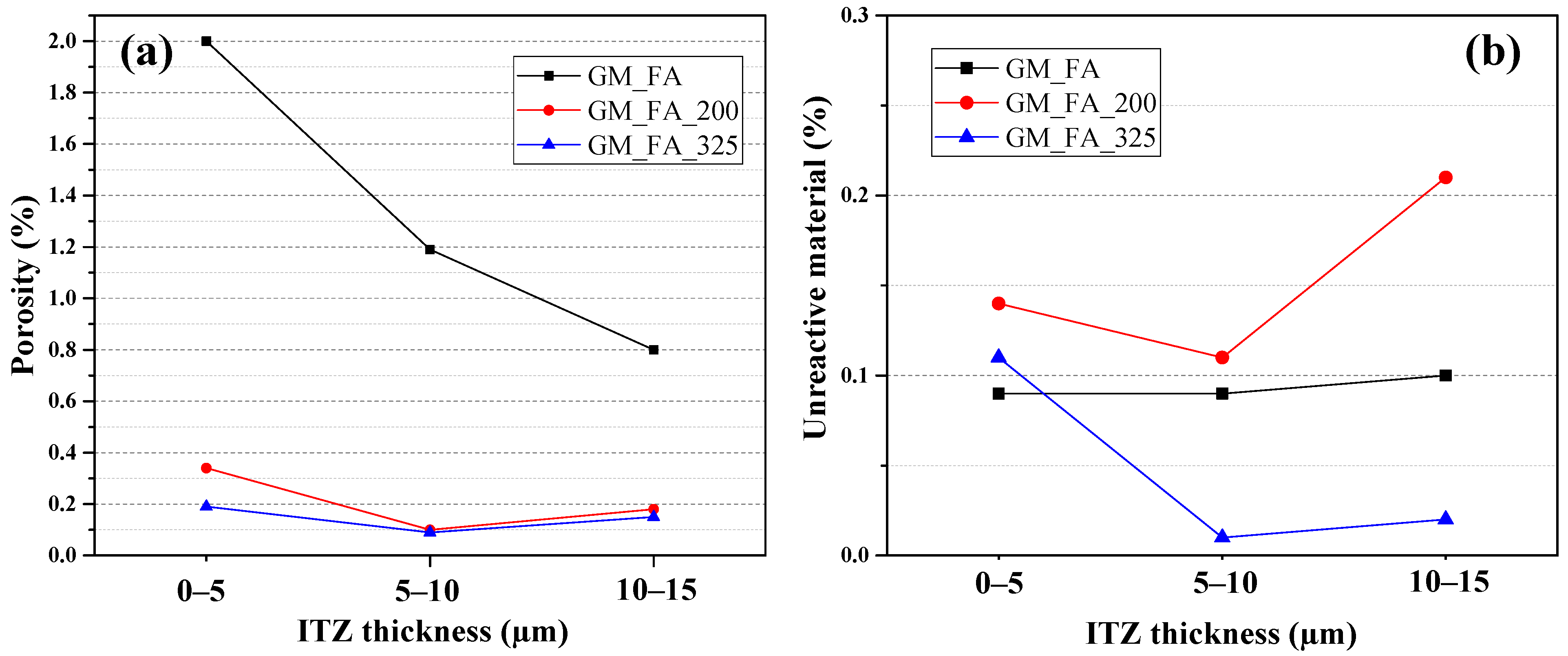

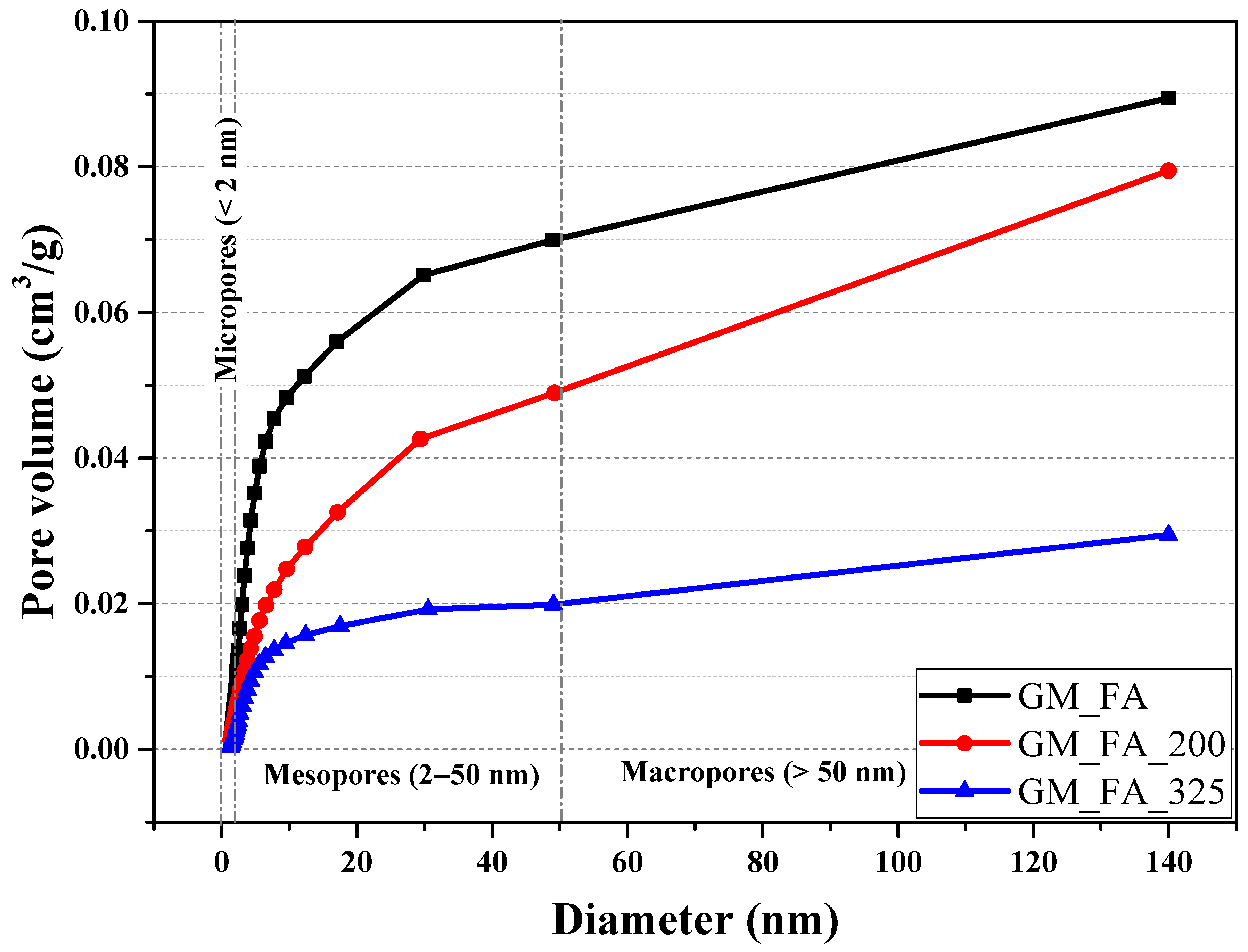
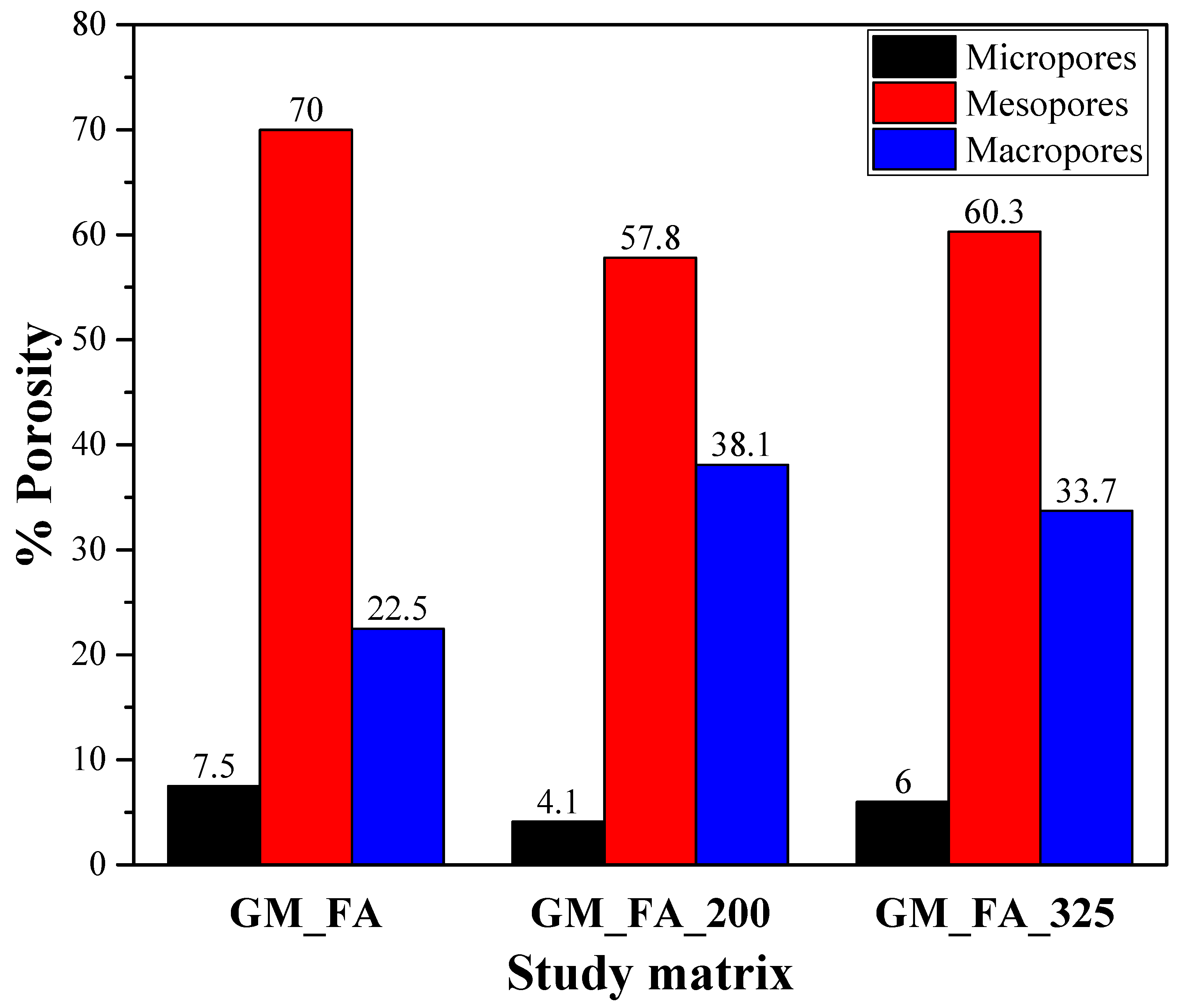
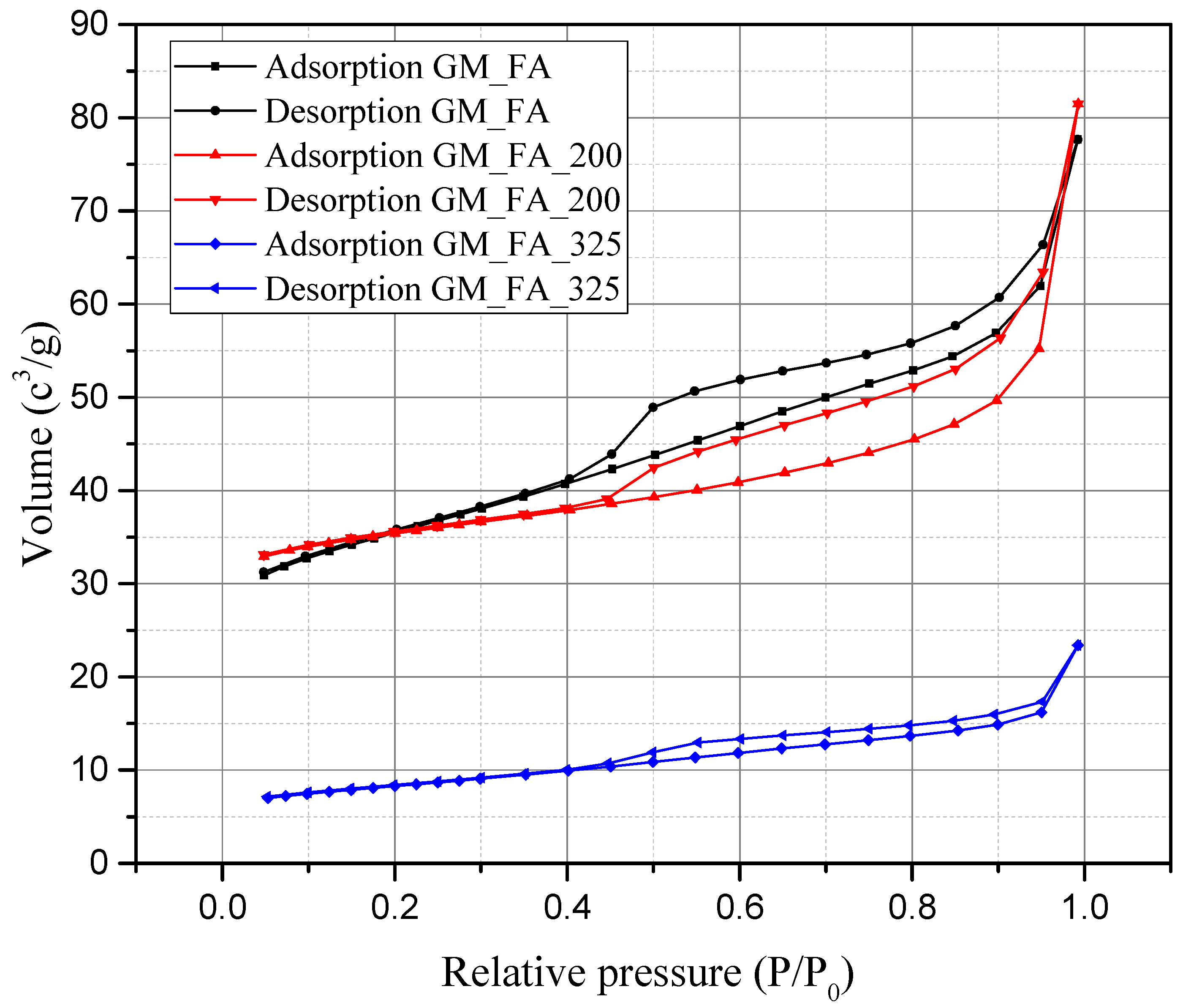
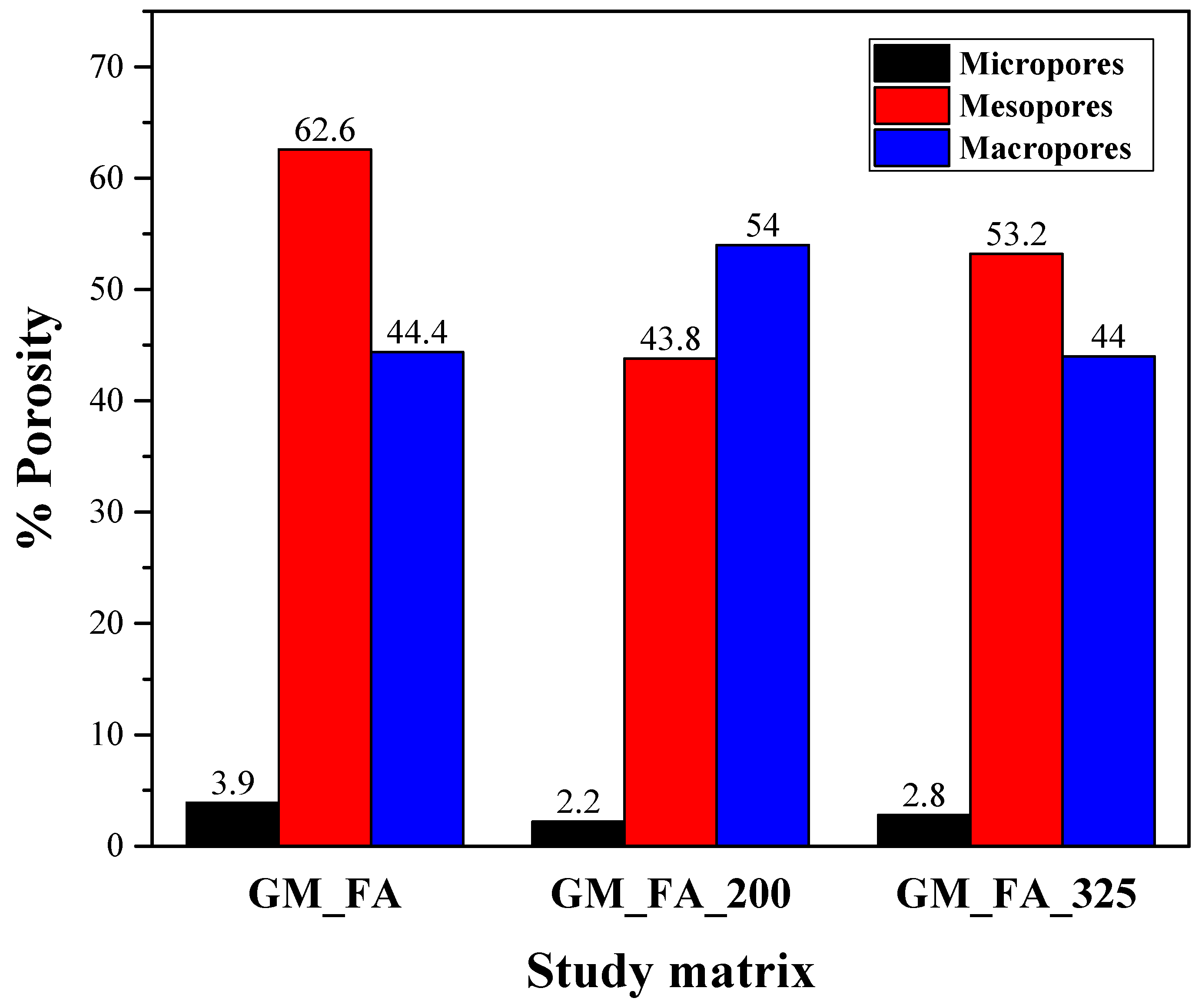
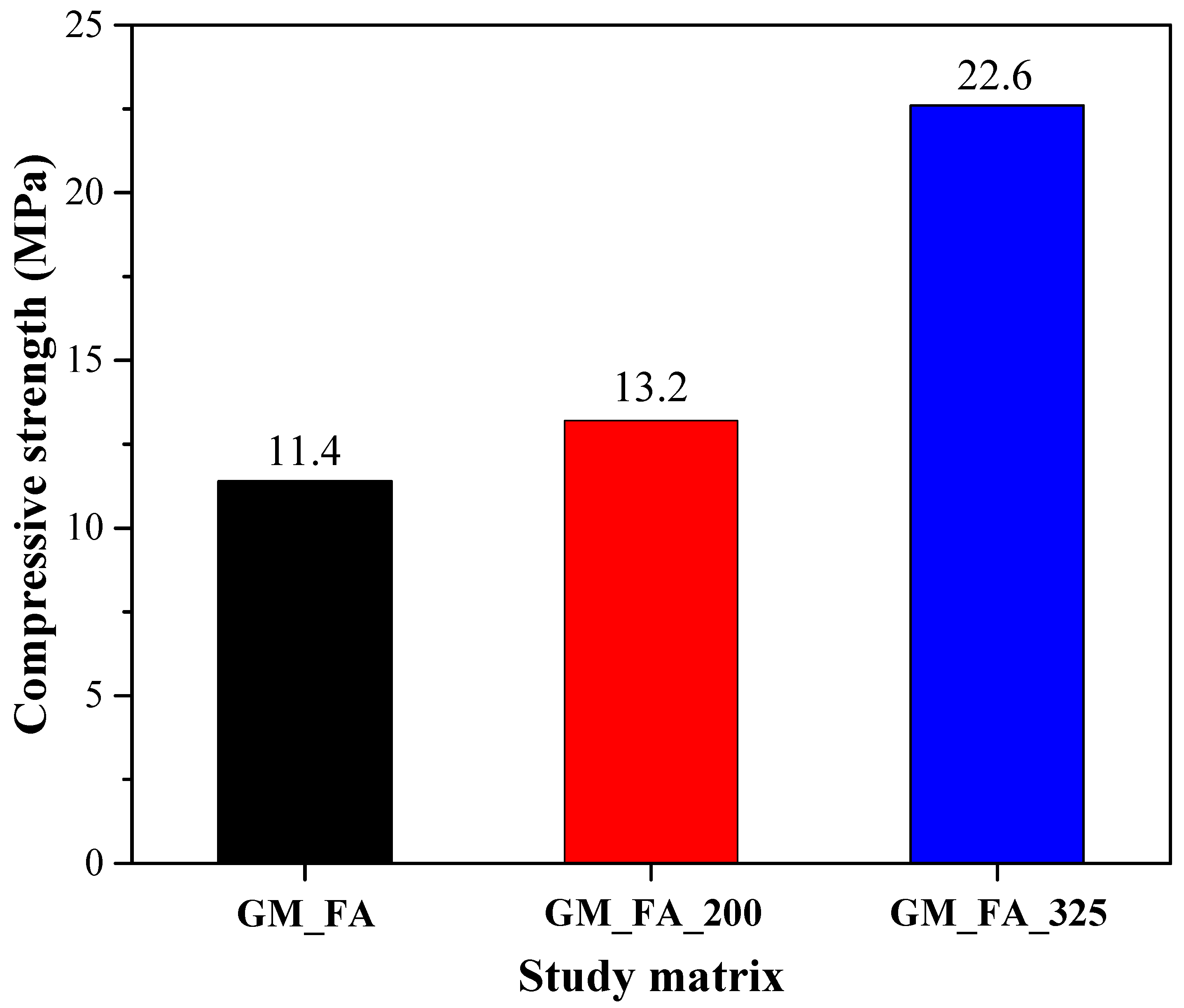
| Composition | SiO2 | Al2O3 | Fe2O3 | CaO | MgO | K2O | Na2O | SO3 | TiO2 | LOI * |
|---|---|---|---|---|---|---|---|---|---|---|
| % by weight | 56.9 | 26.24 | 5.56 | 4.25 | 0.72 | 1.21 | 0.346 | 0.71 | 1.21 | 2.47 |
| Designation | Sieve | Grinding Method | NaOH | NaOH/FA Ratio | Silica Sand | Thermal Treatment | Curing Time |
|---|---|---|---|---|---|---|---|
| GM_FA | - | - | 8 M | 0.4 | Present | 80 °C, 24 h, 90% RH | 28 days |
| GM_FA_200 | #200 | Mechanical | 8 M | 0.4 | Present | 80 °C, 24 h, 90% RH | 28 days |
| GM_FA_325 | #325 | Mechanical | 8 M | 0.4 | Present | 80 °C, 24 h, 90% RH | 28 days |
Disclaimer/Publisher’s Note: The statements, opinions and data contained in all publications are solely those of the individual author(s) and contributor(s) and not of MDPI and/or the editor(s). MDPI and/or the editor(s) disclaim responsibility for any injury to people or property resulting from any ideas, methods, instructions or products referred to in the content. |
© 2025 by the authors. Licensee MDPI, Basel, Switzerland. This article is an open access article distributed under the terms and conditions of the Creative Commons Attribution (CC BY) license (https://creativecommons.org/licenses/by/4.0/).
Share and Cite
Rosas-Casarez, C.A.; Corral-Higuera, R.; Arredondo-Rea, S.P.; Gómez-Soberón, J.M.; Chinchillas-Chinchillas, M.J.; Rodríguez-Rodríguez, M.; Pellegrini-Cervantes, M.J.; Bernal-Camacho, J.M. Porosity of Geopolymers Using Complementary Techniques of Image Analysis and Physical Adsorption of Gases. Buildings 2025, 15, 2353. https://doi.org/10.3390/buildings15132353
Rosas-Casarez CA, Corral-Higuera R, Arredondo-Rea SP, Gómez-Soberón JM, Chinchillas-Chinchillas MJ, Rodríguez-Rodríguez M, Pellegrini-Cervantes MJ, Bernal-Camacho JM. Porosity of Geopolymers Using Complementary Techniques of Image Analysis and Physical Adsorption of Gases. Buildings. 2025; 15(13):2353. https://doi.org/10.3390/buildings15132353
Chicago/Turabian StyleRosas-Casarez, Carlos A., Ramón Corral-Higuera, Susana P. Arredondo-Rea, José M. Gómez-Soberón, Manuel J. Chinchillas-Chinchillas, Margarita Rodríguez-Rodríguez, Manuel J. Pellegrini-Cervantes, and Jesús M. Bernal-Camacho. 2025. "Porosity of Geopolymers Using Complementary Techniques of Image Analysis and Physical Adsorption of Gases" Buildings 15, no. 13: 2353. https://doi.org/10.3390/buildings15132353
APA StyleRosas-Casarez, C. A., Corral-Higuera, R., Arredondo-Rea, S. P., Gómez-Soberón, J. M., Chinchillas-Chinchillas, M. J., Rodríguez-Rodríguez, M., Pellegrini-Cervantes, M. J., & Bernal-Camacho, J. M. (2025). Porosity of Geopolymers Using Complementary Techniques of Image Analysis and Physical Adsorption of Gases. Buildings, 15(13), 2353. https://doi.org/10.3390/buildings15132353









